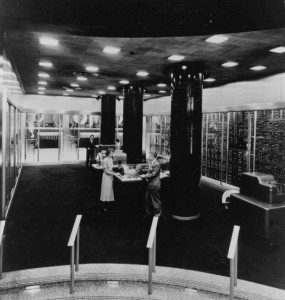 The Selective Sequence Electronic Calculator was first introduced to the public on January 27th, 1948. It was a hybrid, made up of a mix of electromechanical relays and vacuum tubes. It was put on display behind a large window in the ground floor of IBM’s New York headquarters, and was nicknamed “Poppa” by the public for it’s noisy operation.
The Selective Sequence Electronic Calculator was first introduced to the public on January 27th, 1948. It was a hybrid, made up of a mix of electromechanical relays and vacuum tubes. It was put on display behind a large window in the ground floor of IBM’s New York headquarters, and was nicknamed “Poppa” by the public for it’s noisy operation.
Although not completely electronic, it was the first to treat programmed instructions as data and had many features of stored program machines that would come about later. Like most computers of the day it was a large machine that took up a lot of space, occupying a 60 by 30 foot room.
The all electronic ENIAC had already been introduced prior to completion of the SSEC, and it was quickly outdated. It was used mainly as a public relations prop and served that role well until it ceased operation in 1952 and the new IBM 701 was placed on display instead.



